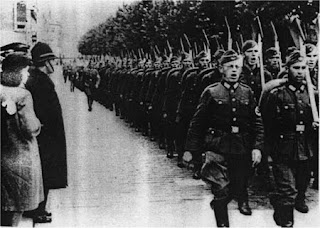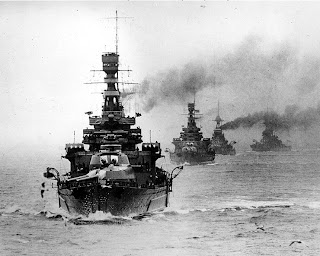 |
| British police watch German soldiers in occupied Jersey |
Druids planning outdoor rituals know that the weather in these Isles can be a little fickle. This autumn we had a mild weekend for our, now officially 'religious' rites, but this time of year you can't always guarantee that.
Seventy years ago though it wasn't Druids who were hoping for mild weather over the equinox. In fact,if there were any around, they were wishing for exactly the opposite as across the Channel, in occupied France, German Generals were wondering whether a rag-tag fleet of requisition Rhine barges would really be able to transport their army across the sea to England.
 |
| Requisitioned Rhine barges |
In the event
Operation Sea Lion was called off at the end of August. The weather, unusually mild for the time of year in 1940, would have been the least of Germany's worries. An undefeated RAF, a rapidly reforming Army, a fully mobilised Royal Navy, and an unyielding Winston Churchill stood waiting for them and Hitler chose to strike east at Russia rather than risk a Channel crossing.
But could things have been different? If just one of these factors could be changed, could Germany have won the war in 1940? In the frustrating and occasionally illuminating world of Counter-Factual History, anything is possible.

Firstly there's the weather. The invasion was scheduled for the period 19th - 26th September, when the tide was right to allow the invasion barges to land at high tide and avoid the improvised defences on the beaches (made from builders scaffolding - a far cry from the concrete of the Atlantic Wall that faced the Allies on D-Day.) A low pressure suddenly turned left and headed for Norway leaving calm seas for the barges. Hindsight tells us the invaders would have crossed safely, but the German planners didn't have hindsight. An accurate seven day forecast was impossible with 1940s technology. In 1944 the Allies had ships at sea to help, but it was still a bit of a gamble. It would have been a brave man who launched his flat bottomed barges into the English Channel that September.
But it wasn't the weather that led to
Sea Lion being cancelled, but the failure of the Luftwaffe to defeat the RAF in the Battle of Britain. Could they have won? On the face of it, no. Contrary to some myths, the RAF never came close to loosing. In 1940 we had the best air defence system in the world and the Germans barely dented it.
However the RAF was quite capable of defeating itself. Dowding used his planes as aerial guerrillas, attacking the Luftwaffe by surprise in small groups, disrupting their formations and disappearing into thin air. It worked, but was unpopular. Dowding had devised the system, but it was the individual squadron leaders who carried it out. It takes a selfless leader to delegate such responsibility, and few of Dowding's colleagues shared his gift. The rival 'Big Wing' tactics were ineffective when tried, shooting down just a single German fighter in ten massive sorties, but it was popular with such charismatic fliers as Douglas Barder.
In November 1940 Dowding was ousted from the top of the RAF by the 'Big Winger' Leigh-Mallory. Leigh-Mallory was eventually to use his ideas in battle over occupied France, where the Germans shot his planes out of the sky at four times the rate they were downing Luftwaffe aircraft. Fortunately by this stage of the war it didn't really matter.
So with a favourable weather forecast and the RAF immolating itself with the wrong tactics, the German Army could well have set forth on the invasion of England. In May 1940 they had sent the British Expeditionary Force packing from Belgium, and morale would have been sky high. But the army that struggled ashore from its rickety barges would not have been the force that had overrun Poland and France, whilst the British Army it faced was not the bedraggled and demoralised one that had limped home from Dunkirk four months earlier.
 |
| Improvised armoured vehicles |
Only a handful of tanks would have accompanied the invaders, whilst the defenders, under the command of possibly Britain's best General of the war, had assembled a small number of motorised brigades to oppose them. General Brooke only had a few tanks himself, but they would probably have been enough to at least hold the Germans. The invaders would also have found that Britain's renowned sense of fair play has temporarily gone on strike, and there were plans to set fire to the sea, carry out sabotage in the German's rear areas and even drop mustard gas on the Germans. Unless reinforcements could be brought up quickly, the Germans would have been unlikely to have captured more than a few square miles of England.
 |
| The Home Fleet |
Whether or not the second wave would have made it would depend on the Royal Navy. The Navy was aware of the danger, and had been recalling cruisers and destroyers from all over the world. Later experience in the Pacific would suggest that warships could be defeated by air power, but at this stage of the war that might not be true. The Luftwaffe had very little experience of attacking ships and if the worst came to the worst the Royal Navy would have brought out its Battleships - and the Germans simply didn't have a bomb big enough to destroy a Battleship. Maybe if their own Battleships the
Tirpitz and the
Bismark, or the aircraft carrier
Graf Zeppelin, had been finished they might have had a chance, but as things stood in September 1940, they didn't.
All this though assumes though that Britain still wanted to fight. The crucial decisions were made in a series of War Cabinet meetings held between 25th and 28th May 1940. The French Army was collapsing and the Royal Navy were desperately trying to evacuate the BEF from Dunkirk. Things looked grim.
 |
| Churchill (left) and Hastings (right) |
The War Cabinet consisted of Churchill, the affable Tory Peer Lord Halifax, former Prime Minister Neville Chamberlain, and the Labour men Clement Attlee and Arthur Greenwood. Later in the war Cabinet meetings would become mere formalities as nobody would dare challenge Churchill, but only two weeks into the job, Winston did not at this time have the authority he later earned.
Churchill wanted to fight on regardless, Halifax meanwhile wanted to open negotiations using the Italians as intermediaries, something that Churchill thought would destroy the countries fragile morale when the news inevitably leaked out. Attlee favoured Churchill's position, whilst Greenwood appears to have been on the fence, but in any event the Labour men would probably have been unwilling to challenge the Conservatives at this point in the Coalition Government. The balance was therefore held by Chamberlain.
History has not been kind to Neville Chamberlain. He was not a great Prime Minister, but neither was he all that bad. A One Nation Tory more interested in reform at home than war abroad, he was the wrong man for the job in such troubled times. He usually gets the blame for Munich, but in 1938 the Opposition, and the country as a whole, were not ready to fight. He also appeased the fascists in the Spanish Civil War, but Churchill was right behind him on that one. In 1940 though, despite his instincts for peace, he came down on the side of war. Bolstered by a favourable report from the Navy he backed Churchill and Britain fought on.
 |
| Top men; Churchill and Chamberlain |
But what if the people present at those fateful meetings had been sat in different seats? Perhaps here we have nearest to a possible alliterative history.
Wind the clock back a fortnight to another meeting at Westminster, this time between Chamberlain, Halifax, Churchill and Chief Whip David Margesson. Margesson has just told Chamberlain that Attlee will not enter a coalition whilst he is Prime Minister. Chamberlain then bluntly turned to Halifax and Churchill and asked who should succeed him. There then followed a very long pause indeed before Halifax ruled himself out.
Had he not done so he would probably have become Prime Minister. He was most likely Chamberlain's preferred choice. Churchill, although he had been right about Hitler, had been responsible for the disaster of Gallipoli in the First World War and Narvik in this one. A maverick and a rebel, who annoyed the Conservatives by joining the Liberals and had wound up the Trade Unions by using armoured cars during General Strike, he was hardly the ideal choice to lead a Government of National Unity.
Whilst Churchill had been turing up in the House of Commons drunk to defend the pro-Nazi King Edward VIII and railing against "the twin dangers of Hitler and Ghandi", Halifax meanwhile had been Governor of India, where he had actually released the Mahatma from jail and invited him to private talks. Politically they were chalk and cheese.
Churchill would have continued to serve under Halifax, but as the latter was one of the architects of Appeasement there is little doubt what Prime Minister Halifax would have done on 25th May. Britain would have made peace and Germany would have given terms that Halifax could not refuse.
There would not have been a Battle of Britain and no need for an
Operation Sea Lion but there would also have been no D Day. It's difficult to say who would have won the war, but the result would be that either Hitler or Stalin would have become master of the whole of Europe.
There would probably have still been a Cold War between a totalitarian Europe and a democratic America, but without British nuclear physicists there may not have been a Manhattan Project. The first atomic bomb might have been built by Heissenberg or Kurchatov and fitted to one of Wernher von Braun's rockets - the man almost certainly having no qualms about serving whoever would let him play with his dangerous toys.
And so history turned. Churchill, the warmonger, became the hero and Halifax, the peacemaker, was forgotten. Britain fought on, Brooke's soldiers and the Royal Navy waited for an enemy that never came, the RAF won the Battle of Britain and whilst the weather remained calm, the German barges stayed in port. Hitler turned East and the rest is history. Real history.
Bibliography
Operation Sea Lion Richard Cox
Fateful Choices Ian Kershaw
More What If? Robert Cowley (editor)

 The recent Wikileaks Iraq War Diaries have showed how US approved torture didn't end in 1974. A repeating meme in the logs is how US and British forces repeatedly turned a blind eye, and even handed suspects over for interrogation to known abusers.
The recent Wikileaks Iraq War Diaries have showed how US approved torture didn't end in 1974. A repeating meme in the logs is how US and British forces repeatedly turned a blind eye, and even handed suspects over for interrogation to known abusers.













